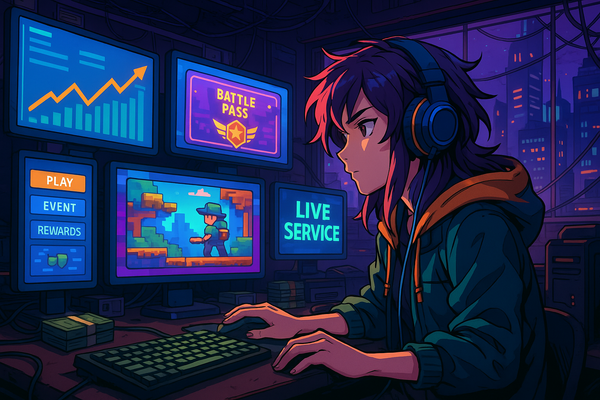Unlocking Success: Key Metrics every game developer should track
In the dynamic world of game development, understanding and tracking the right metrics is crucial for success. Whether you are a budding indie developer or a seasoned studio, these metrics provide invaluable insights into player behavior, game performance, and overall business health. Here, we dive into the essential metrics every game developer should monitor to ensure their game thrives.
Progression Metrics
Progression metrics help developers understand how players advance through the game, which can reveal both successes and pain points in the game design.
- Unlock Rates for Features/Items: Monitoring how often players unlock new features or items can highlight which aspects of your game are most engaging. If certain features are rarely unlocked, it might indicate that they are too difficult to access or not appealing enough, leading you to rethink their design or placement.
- Average Time to Finish Level: This metric helps balance the difficulty of your levels. If players consistently spend too much time on a particular level, it might be too challenging, potentially leading to frustration. Conversely, if they breeze through it, it might be too easy and not engaging enough.
- Player Level Distribution: Understanding the spread of player levels across your user base can identify where players are dropping off. If a significant number of players are stuck at a particular level, it could indicate a difficulty spike that needs addressing.
- Level Completion Rates: Similar to player level distribution, this metric helps pinpoint levels that might be too difficult or too easy. High completion rates might suggest the need for more challenging content, while low rates could indicate frustration points.
- Feature Usage Rates: Tracking how frequently different features are used can provide insights into player preferences and guide future updates. If a feature is rarely used, it might need reworking or better in-game tutorials to highlight its benefits.
- Churn Rate: Keeping an eye on how many players leave your game helps in understanding retention issues. A high churn rate might indicate that players are not finding long-term engagement, necessitating changes in content or mechanics.
Engagement Metrics
Engagement metrics reveal how deeply players are involved with your game, offering insights into player satisfaction and stickiness.
- Levels per Session: Indicates the average number of levels a player completes in one session. High levels per session suggest that players find your game compelling enough to play multiple levels at a time.
- DAU / WAU / MAU: Daily, Weekly, and Monthly Active Users help gauge your game's popularity over time. A steady increase in these metrics signifies growing interest and engagement.
- Retention D1-D360: Tracking daily retention rates from Day 1 to Day 360 can show how well your game retains players long-term. High early retention rates indicate good initial engagement, while long-term retention highlights sustained interest.
- Sessions Per User: The average number of sessions per user provides a glimpse into player engagement levels. Frequent sessions per user suggest that your game is part of their regular routine.
- Session Length: Average session duration indicates how compelling your gameplay is. Longer sessions suggest that players are deeply engaged and immersed in your game.
- Playtime: Total playtime shows overall game engagement and longevity. High playtime indicates that players are consistently coming back and spending substantial time in your game.
Balance Metrics
Balance metrics ensure the in-game economy and difficulty are fair and engaging.
- Currency Consumption Per User: Tracks how much in-game currency players are spending. This can help you understand if your economy is balanced or if adjustments are needed to make earning and spending currency more rewarding.
- Income/Spending by Source: Breaks down where players earn and spend currency. This can highlight which game activities are most profitable and which ones might need incentives to encourage participation.
- Currency Income Per User: Average amount of currency earned helps balance rewards. If players are earning too little, they might feel frustrated; too much, and the challenge might diminish.
- Currencies Per User: Total amount of various currencies held by users. This can help track the overall economic health of your game and identify potential inflation issues.
- Attempts Per Level: Indicates how many tries players need to complete a level. High attempts might indicate that a level is too hard, while low attempts could suggest it’s too easy.
- Win/Loss Ratio: Balances the challenge by showing wins versus losses. A balanced win/loss ratio ensures players feel challenged but not frustrated.
Technical Metrics
Technical metrics are crucial for ensuring smooth and enjoyable gameplay.
- Build Size: The size of your game’s build can impact download and update times. Smaller build sizes are generally preferred for better user experience.
- Load Time: Faster load times improve user experience, making players more likely to continue playing your game.
- ANR Rate: Application Not Responding rate shows how often your game freezes. High ANR rates can frustrate players and lead to churn.
- Crash Rate: Frequency of game crashes, which can seriously harm user retention. Lowering the crash rate should be a priority for a seamless gaming experience.
- Frame Rate (FPS): Smooth gameplay is indicated by a high, stable frame rate. Fluctuations in FPS can degrade the player experience.
Community & Support Metrics
These metrics help maintain a positive relationship with your player base.
- Social Media Engagement: Measures interactions on social media platforms. High engagement suggests an active and interested community.
- User Reviews and Ratings: Provides direct feedback from players. Positive reviews and high ratings can attract new players, while negative feedback can highlight areas for improvement.
- Response Time: Time taken to respond to player queries or issues. Quick response times can improve player satisfaction and loyalty.
- Common Issues: Frequently reported problems that need addressing. Identifying and fixing common issues can improve overall player satisfaction.
- Support Tickets Volume: Number of support tickets can indicate the level of player satisfaction. High volume might suggest underlying issues that need resolving.
Marketing Metrics
Marketing metrics are essential for growing your player base and maximizing the efficiency of your marketing efforts.
- ROAS: Return on Ad Spend shows the revenue generated per dollar spent on advertising. High ROAS indicates effective advertising strategies.
- k-Factor: Viral growth rate of your game. A high k-factor means your players are actively bringing in new players, reducing the need for paid acquisition.
- CPI / CPM: Cost to acquire one install or cost per thousand impressions. Lower CPI/CPM suggests more cost-effective marketing.
- CVR / CTR: Conversion Rate and Click-Through Rate for marketing campaigns. High CVR/CTR indicates that your ads are compelling and relevant.
- Target Spend: Budget allocation for marketing efforts. Keeping within target spend ensures you are not overspending on acquisition.
- Monthly Installs: Number of installs per month to track growth. Increasing monthly installs suggest successful marketing efforts.
Monetization Metrics
Monetization metrics are key to understanding how your game generates revenue.
- Ads Fill Rate: Percentage of ad requests that are filled. High fill rates ensure that you are maximizing ad revenue potential.
- ARPU / ARPPU: Average Revenue Per User and Average Revenue Per Paying User. Higher ARPU/ARPPU indicates effective monetization strategies.
- LTV / Avg. Check: Lifetime Value of a user and average transaction amount. Higher LTV suggests long-term player engagement and spending.
- Conversion Rate: Percentage of users who make a purchase. Increasing conversion rates can significantly boost revenue.
- Payer Cohort Distribution: Breakdown of paying users by cohort. Understanding payer distribution helps in targeting monetization efforts.
- Player Spendings by Sources: Analysis of where players are spending their money. Identifying popular spending sources can guide future content and updates.
Business Metrics
Business metrics give a high-level view of your game's financial health.
- Revenue: Total income generated. Tracking revenue helps measure overall business success.
- IAP Revenue: Revenue from in-app purchases. High IAP revenue indicates successful monetization of premium content.
- Burn Rate: Rate at which you are spending money. Keeping burn rate in check ensures sustainability.
- ROI: Return on Investment to evaluate the efficiency of your investments. High ROI indicates profitable investments.
- Operating Expenses: Costs incurred in running the business. Managing operating expenses helps in maintaining profitability.
- Ads Revenue: Income generated from advertisements. Maximizing ad revenue can significantly contribute to overall earnings.
- Profit: Total revenue minus expenses. Tracking profit ensures that your game is financially viable.
By diligently tracking these metrics, developers can gain a comprehensive understanding of their game's performance, identify areas for improvement, and make informed decisions to enhance player experience and business outcomes. Remember, the key to success is not just developing a great game, but continuously evolving it based on insightful data.



